Any RevolverGuy who grew up like I did, watching a steady diet of the 1970s police drama Adam-12, will certainly remember those Blue Knights, Malloy and Reed, each drawing a Combat Masterpiece revolver from a clamshell holster that sprung open like magic every time our heroes needed to draw down on some counterculture scumbag. The image of those great sixguns being drawn from the trick holsters was pure TV magic!
But it wasn’t just a slick show for the tube. One of the hallmarks of Adam-12 was that the Los Angeles Police Department (LAPD) worked very closely with Universal Studios to ensure that the program was technically accurate. They had a small army of advisors who worked with scriptwriters, actors and directors to ensure that scenarios, uniforms, equipment, tactics and terminology were authentic. The actors received careful coaching from real lawmen, who taught them how to look and act the part.

So, when Malloy and Reed switched from the Model 14 and Safariland #11 top draw holster to the Model 15 and clamshell holster for Season Four, it wasn’t just for the sexy optics. The LAPD had just switched to the shorter guns in 1969 (which were “neutered” to remove the single action capability, like all LAPD revolvers starting in that year), so the characters who portrayed them on TV would too, and it made sense they would carry the guns in clamshell holsters, which by this time had become an LAPD icon. Malloy and Reed may have brought these clever holsters into the public consciousness in the early 70s, but the clamshell holster story goes back much further. It’s a story fit for a RevolverGuy, so join me as we turn the clock back to rediscover this lost gem from law enforcement’s past.
Springs and things
The inventor of the clamshell holster was Mr. Frank C. Jewett, whose patent for the design was granted on 10 October 1933. In Jewett’s design, the pouch which held the gun was split into two halves along the front seam, which were joined at the rear by a powerful flat spring that was biased to open the halves in butterfly fashion. In operation, the two halves were folded together against the spring pressure and were held closed by a latching mechanism in the front seam of the holster. To open it up, the user inserted the index finger of his gun hand into the area of the trigger guard, and pushed inwards on a camouflaged button (that was hidden underneath a layer of leather, just forward of the trigger face) to release the latch, at which point the halves rapidly separated under spring pressure, releasing the gun.
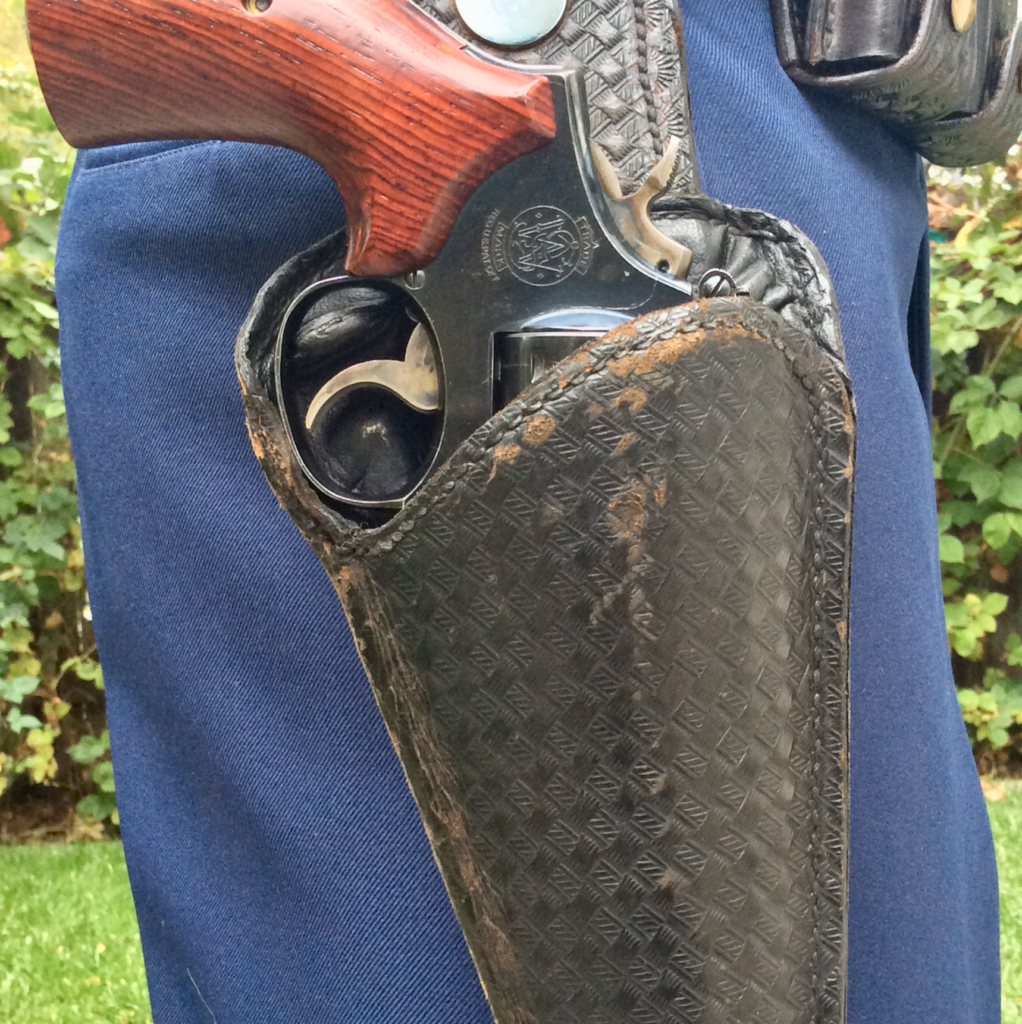
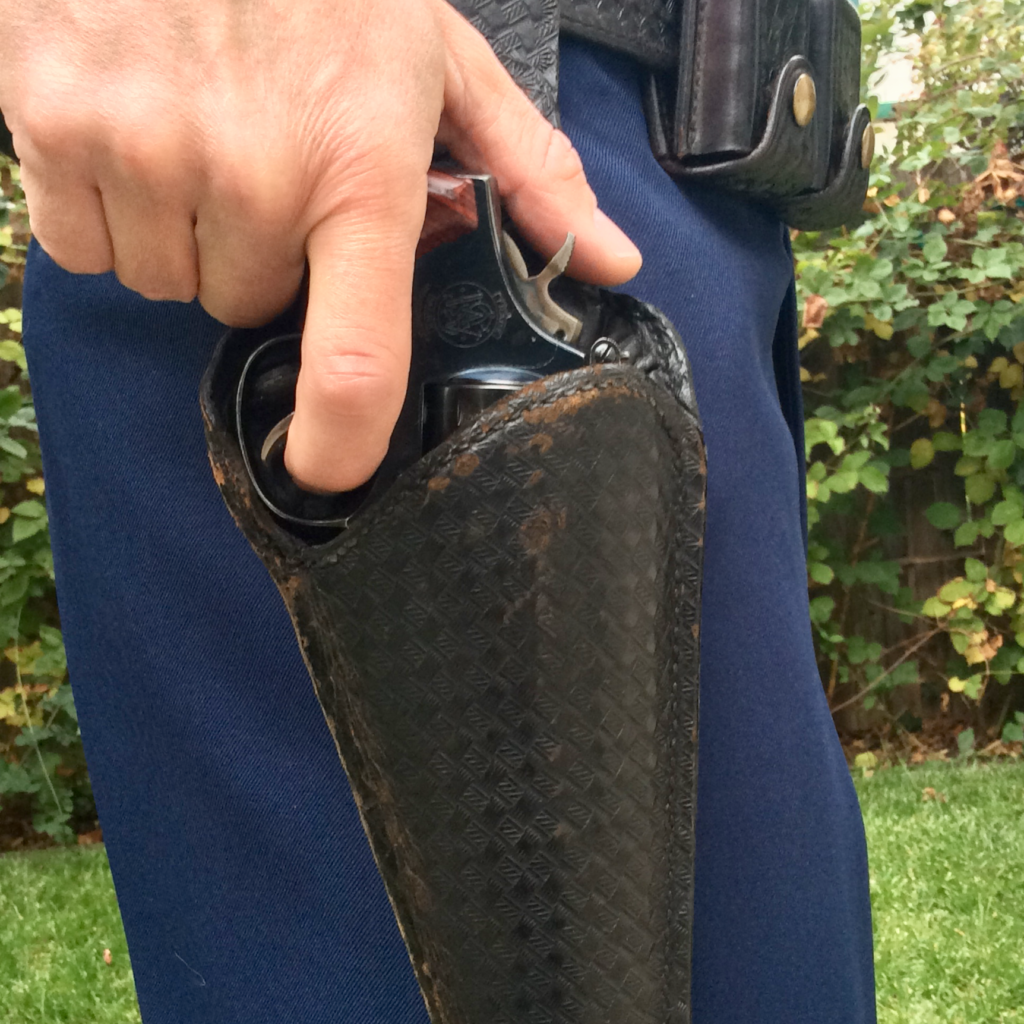
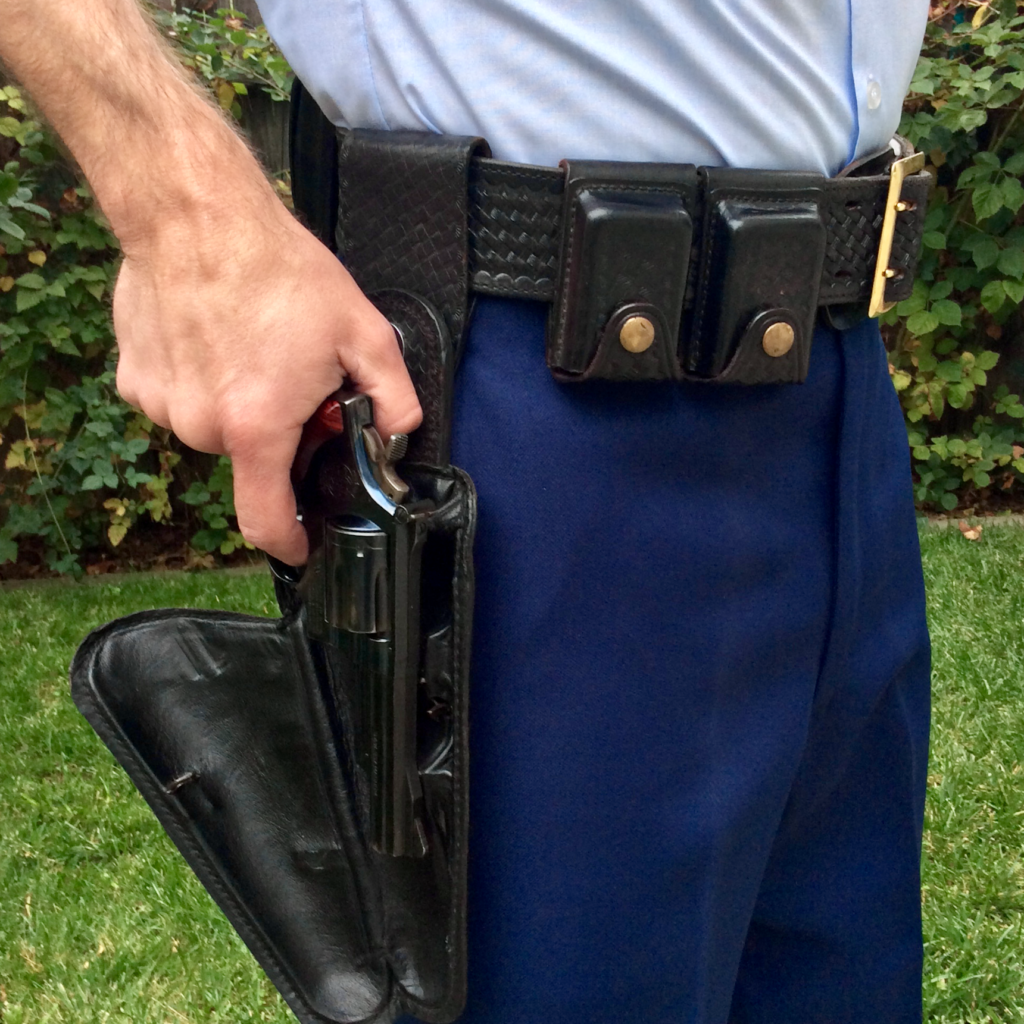
Speed and safety
Jewett hoped to accomplish several objectives with his novel design. The most obvious was a fast and unobstructed presentation of the gun. At the time of the patent, most uniformed police officers (especially those who worked the highways and rural areas) favored revolvers with long, six inch barrels, which were carried in open top pouches and secured by a safety strap. To draw these guns, officers had to release the safety strap, pull them upwards from the pouch until the long barrels cleared the top of the leather, then rotate them to orient the muzzle towards the target.
This didn’t happen very fast. Operating the safety strap was a motion that took some time, and the officer could not establish his grip to draw the gun until this step was complete. When drawing the gun upwards, the long barrels slowed things down, and sometimes the tip of the barrel or the front sight would snag on the mouth of the pouch as the gun was rotated, frustrating the effort to make a clean and smooth draw.
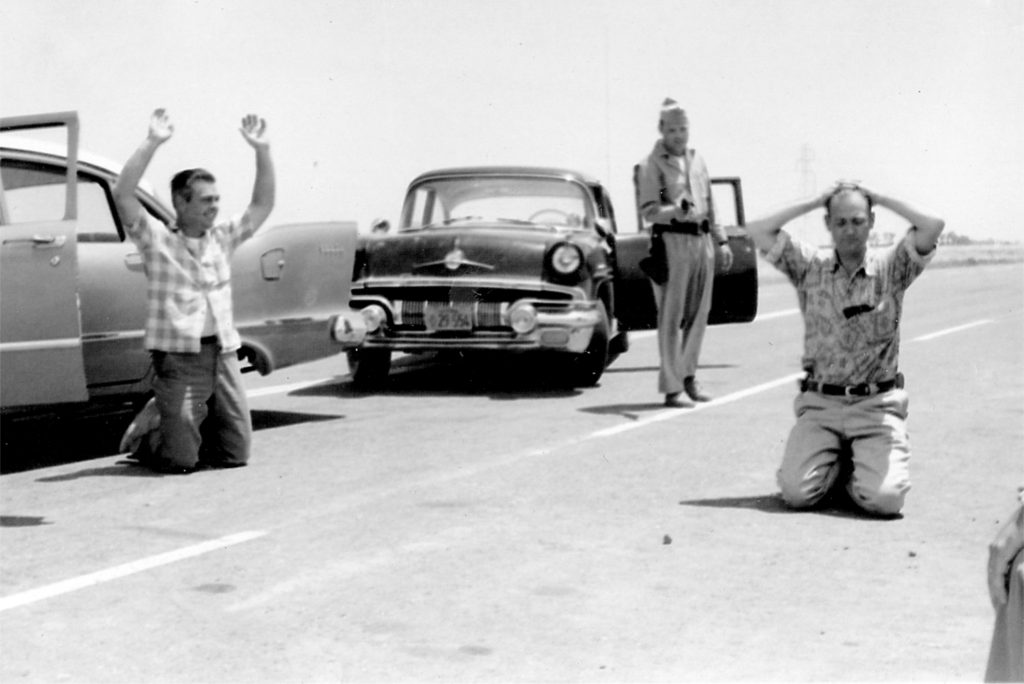
In contrast, with Jewett’s design, the shooter established a normal grip on the gun and punched the hidden button with the fingertip almost simultaneously, at which point the gun could be rotated into the firing position without first having to draw it upwards. The design essentially saved two steps (strap release and upward drawing motion), allowing the shooter to get the gun into play much more rapidly.
Jewett’s design also made significant improvements to security. The two halves of the clamshell were shaped on the inside to fit the gun tightly, so that when the clamshell was locked closed, it would be extremely difficult-practically impossible—to pull the gun out the top of the holster. By hiding the release button from public view, and locating it in a place where access was naturally restricted by the trigger guard, the design made it difficult for someone who was not well-versed in the holster’s operation to get it open. Whereas the typical open top, safety strap, police holster of the time did a poor job of preventing the uninitiated from snatching the gun out of the pouch by simply gripping the gun and pulling on it with great force, the Jewett clamshell did an admirable job of defeating this kind of disarm.
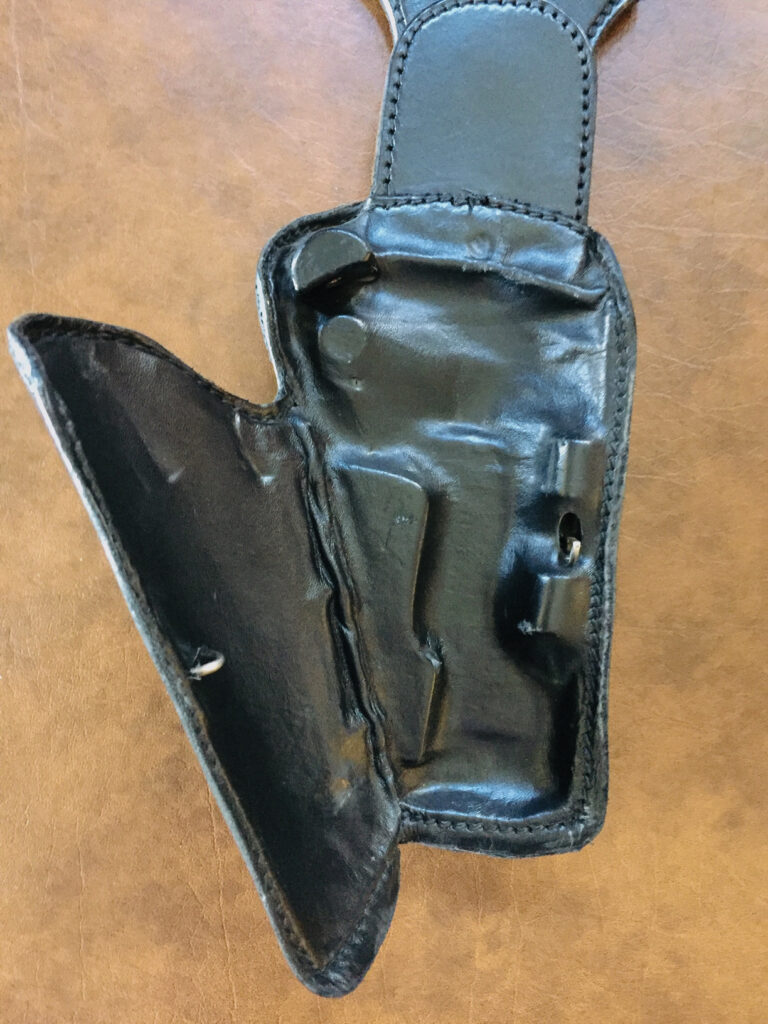
Furthermore, the tightly-fitted interior of the holster helped to prevent cylinder rotation, which made the Jewett design resistant to accidental discharges while the gun was still in the holster. This feature, along with the enhanced retention and security features, gave the holster an edge in safety compared to other contemporary designs of the era.
Production of the Clamshell HOlster
Jewett’s holster was initially produced by the Speed Safety company (which took its name from the two unique qualities of the holster design) from 1932 until somewhere around 1942-43, at which point some of the production rights were sold to another company that operated under the similar name, Safety Speed. The Safety Speed Holster company (est. 1945) operated out of Montebello, California, and became the giant in the clamshell holster business, producing them into the early 1990s. They probably produced more holsters of this design than any other company, and cemented their position as a leading manufacturer of police leather goods.
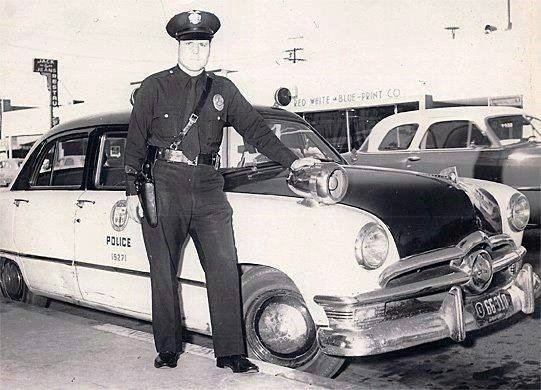
However, they were not alone in the business. The Jewett family married into the Stanroy family, and a collaboration resulted in Stanroy-marked clamshells that competed with Safety Speed. The Stanroy Holster company of Bakersfield, California began production around 1935 and continued until sometime into the late 1960s, with the company establishing a new address in Compton, California, along the way. Of note, the Stanroy facility was near a wrecking yard, which provided an ample supply of auto fenders to stamp into holster frames.
The C.A. Hoffman and Sons holster company also manufactured clamshell holsters beginning around 1936, out of Arlington, California, and there was a host of others that joined them. One of them, an obscure outfit named Jicarilla Apache Tribal (J.A.T.) Industries (located in Dulce, New Mexico), had the notable distinction of producing clamshells for the LAPD under contract, beginning in the late 1960s.
The Clamshell HOlster In Service
The clamshell holsters were first adopted by Southern California lawmen in the pre-war years. They were a particular hit with officers in the various city and county motor units, and the California Highway Patrol (CHP), who favored the six inch revolver and needed a design that was secure, yet fast into action. When the LAPD settled on six inch .38 Special revolvers in the late 1930s, they also embraced the clamshell, issuing the Safety Speed model by the 1940s.
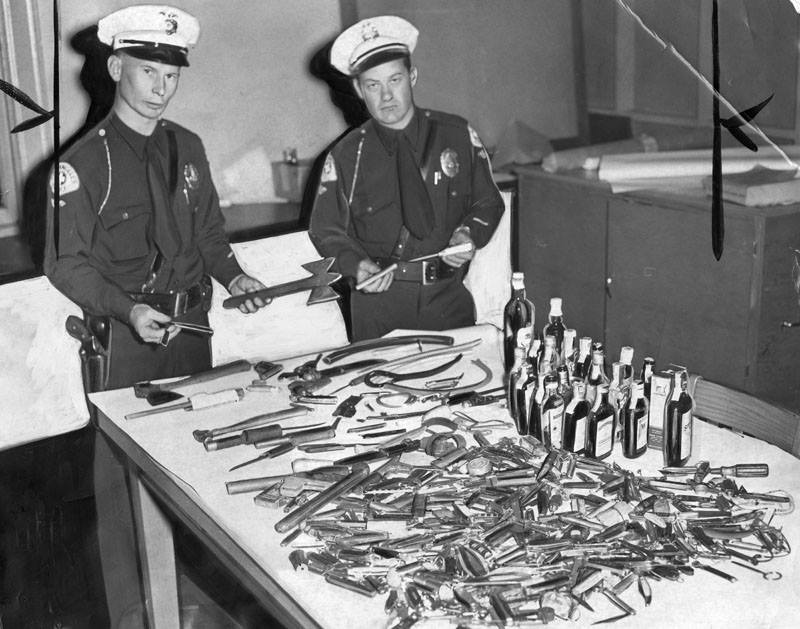
In the post-war era, the design continued to grow in popularity, particularly in Southern California, the heart of clamshell holster production. By the 1950s, the clamshell was a SoCal law enforcement staple, with a host of agencies and individual officers falling for the appeal of the spring holster.
But no agency was so fully committed to the clamshell as the LAPD. After a brief flirtation with Bucheimer top draw swivel holsters in the early-to-mid 1960s proved unsatisfactory, the LAPD returned to the clamshell in the late 1960s and issued them well into the 1970s. At a time when major agencies like the CHP had already traded their clamshells for breakfront designs, the LAPD stood by their old favorite. Even after the department finally switched to a high ride breakfront holster made by Bianchi in the mid-1970s, Los Angeles police officers were allowed to purchase their own clamshells and use them on duty, which they did with great enthusiasm into the 1980s.
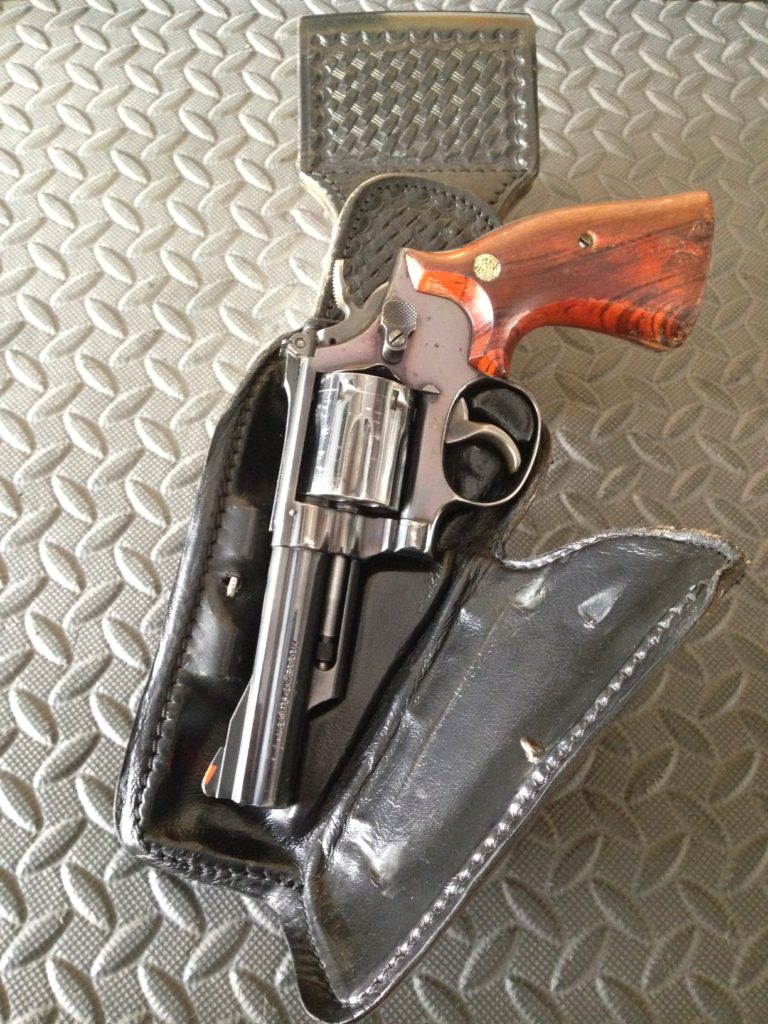
The LAPD’s love for the design was influential, and helped to spread the popularity of the clamshell holster beyond the state’s borders in the post-war years. Yet, while clamshells made their way onto police Sam Brownes all over the nation, Southern California always remained the center of the clamshell holster universe.
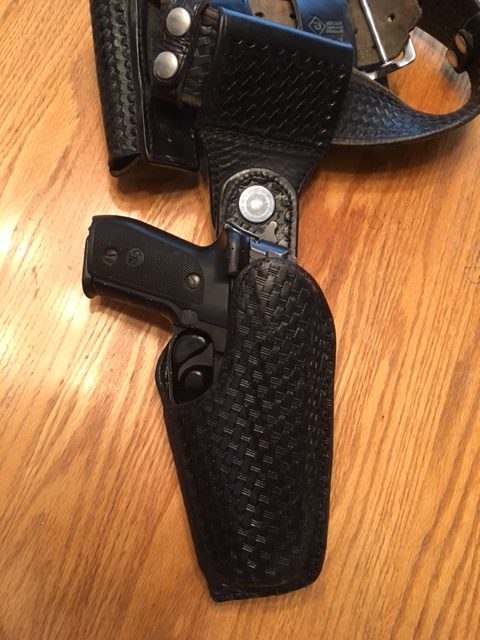
Weaknesses of the Clamshell Holster
As popular as they were, the clamshell holsters had weaknesses that couldn’t be ignored.
The design required the user to put his finger into the trigger guard to release the gun, which led to some negligent discharges when officers fumbled the draw. While placing the trigger finger into the trigger guard during the draw was a commonplace practice during this era, and was encouraged by almost every popular police holster design of the 1940s through the early 1970s (such as the Jordan-style police holster), it created a special hazard in the clamshell holster. Because the gun was left unsupported by the holster when the clamshell opened up, there was a tendency for the trigger finger to grip the trigger in an attempt to keep the gun from falling, especially if a proper grip had not been achieved before the release button was activated. Also, it was easy for the pushing motion of the index finger to continue after the gun had been drawn, with the finger now on the trigger. Some officers, due to a lack of training/practice, inattention, or stress-induced error, managed to negligently pull the trigger with enough frequency that the holster caught the ire of police administrators.
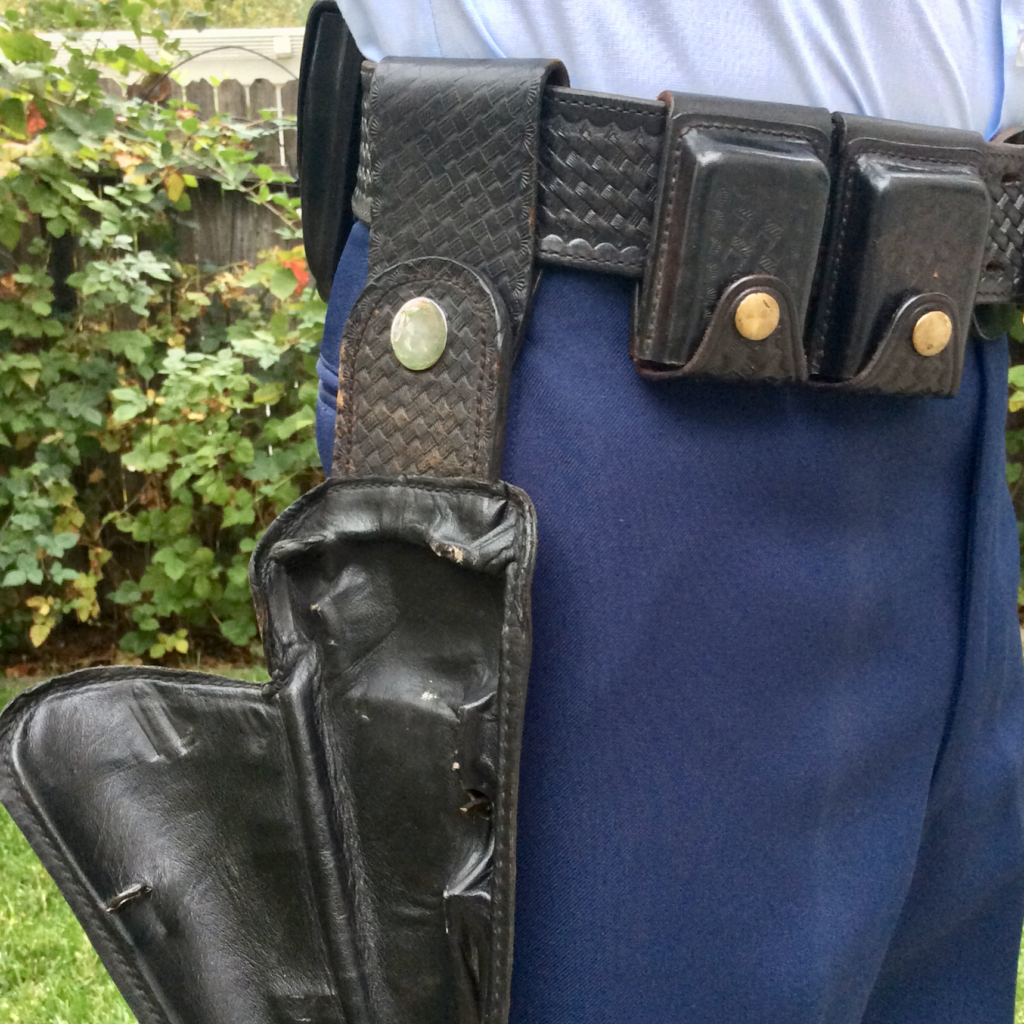
Reholstering a gun in a clamshell holster could be an awkward affair, that usually involved two hands. The gun had to be carefully placed in the proper position, and the two halves squeezed together until they latched. Some officers perfected a method where the gun was placed against the outer shell and held in place by the thumb, as the fingers pushed the clamshell together against the side of the leg, but this could be difficult to execute when the other hand was busy controlling a suspect, and impossible to do on the move. As a result, many officers were forced to tuck guns into their belts or use some other inefficient (and potentially dangerous) workaround when the gun was no longer needed, such as trying to cuff a suspect using only one hand. The effective requirement to reholster with two hands was a big weakness of the clamshell.
There were other potential hazards with clamshells. The spring made a “pop” when the clamshell opened, which could potentially be an issue (some officers learned to restrict the opening of the clamshell with the support hand when noise discipline was important).
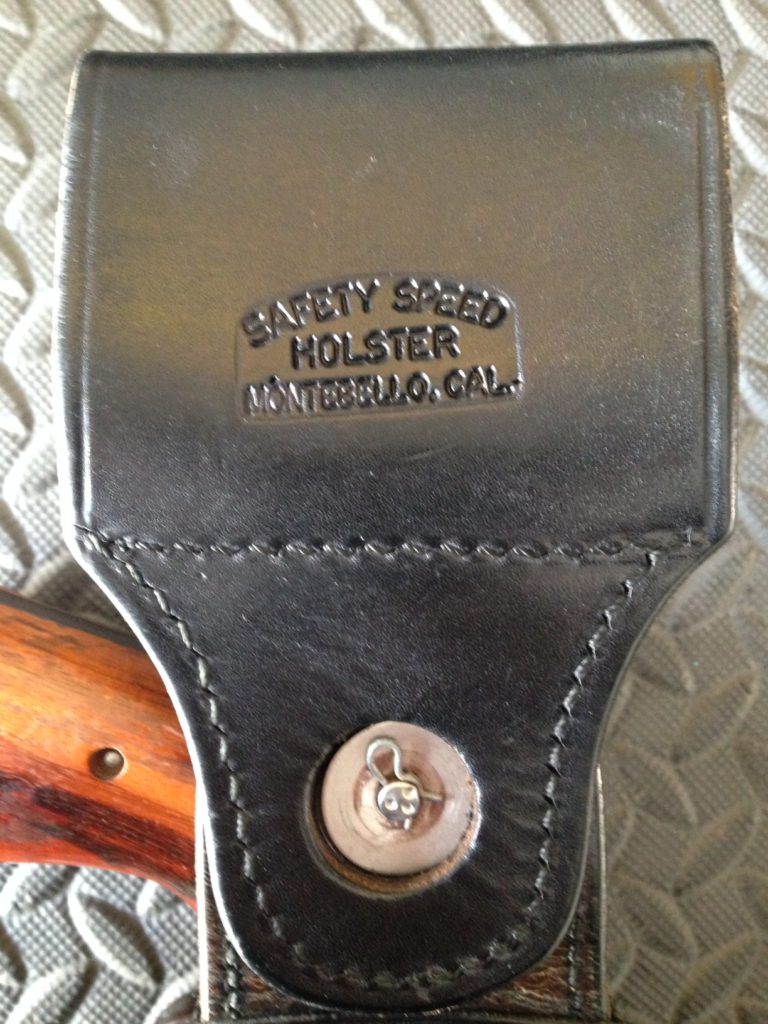
Also, almost all of them were built as swivel holsters, where the holster body hung low from a belt loop, connected to the loop by a rivet. As such, they shared the faults of all swivels. The holster would beat your leg to death if you didn’t hold it when you ran. Worse yet, the rivet sometimes broke, sending the holstered weapon flying on the run, or leaving it behind on the seat of the car, or—God help you—leaving it in a criminal’s hands during a struggle. To help overcome this weakness, some enterprising officers (and later, manufacturers) peened the rivet and installed a cotter pin to prevent a separation.
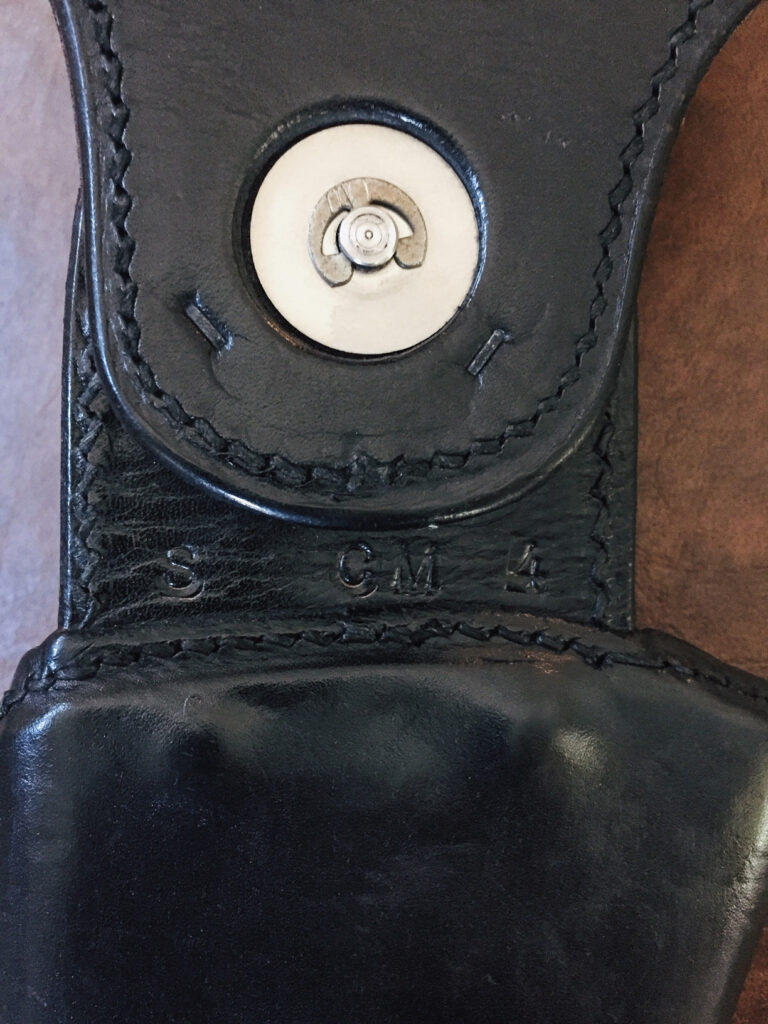
Additionally, since the holster body was made of stamped steel covered with leather, there were occasions where a fall or crash (typically involving a motorcycle officer) resulted in the revolver getting trapped in the crushed holster. This required a careful surgery to cut the holster apart, to get the gun out. The problem was exacerbated by some models that used aluminum shells, in lieu of the steel, to save weight.
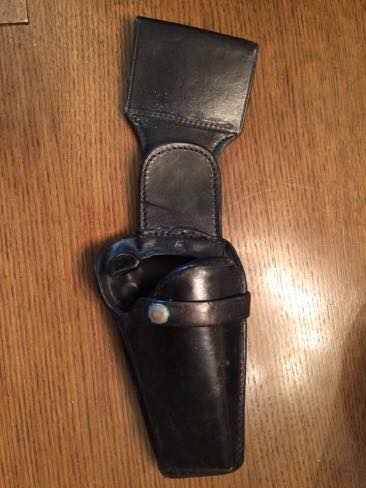
Yet, the most damning problem with the clamshell holster is that it had a disturbing tendency to open up on its own, dumping the gun onto the ground. This was most likely to occur during a foot chase, when the holster bumped against the leg and the jarring motion tripped the latch at the front of the holster. This could happen when the holster’s release mechanism was worn from use, or out of spec because the holster body’s alignment had shifted over time. Some agencies, like the LAPD, had armorers who could inspect and adjust clamshell holsters to ensure more reliable operation, but the design weakness was never perfectly addressed, and it was one of the key reasons that clamshells were eventually prohibited for duty use (as LAPD finally did, in the mid-1980s).
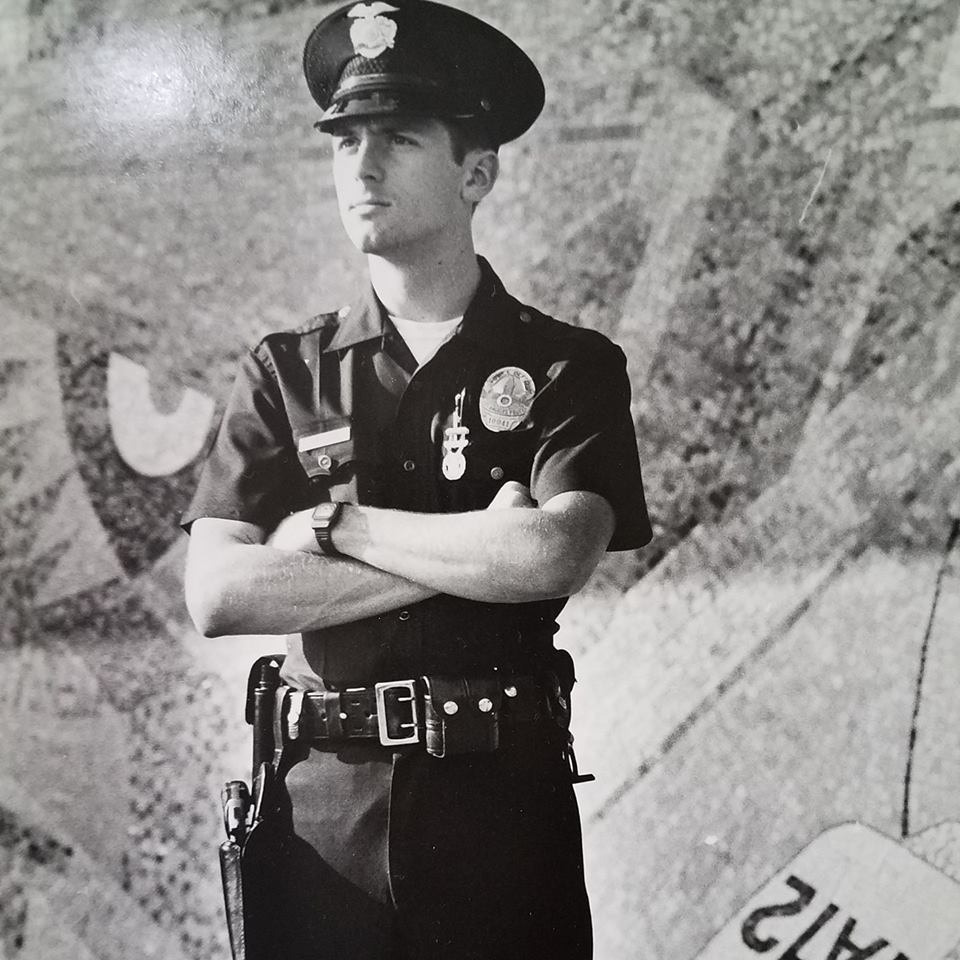
Loved anyways
Despite all of these issues, the clamshells remained very popular for decades. They had their warts, but so did the other police duty holsters of the 1930s to 1980s (and beyond). Yes, clamshell coppers had to hold onto their holsters when they ran, had to get them readjusted once in a while so their sixgun didn’t go tumbling, and often longed for a third hand when it was time to reholster, but they thought the tradeoffs were worth it to have the fastest rig around for a six inch duty gun.
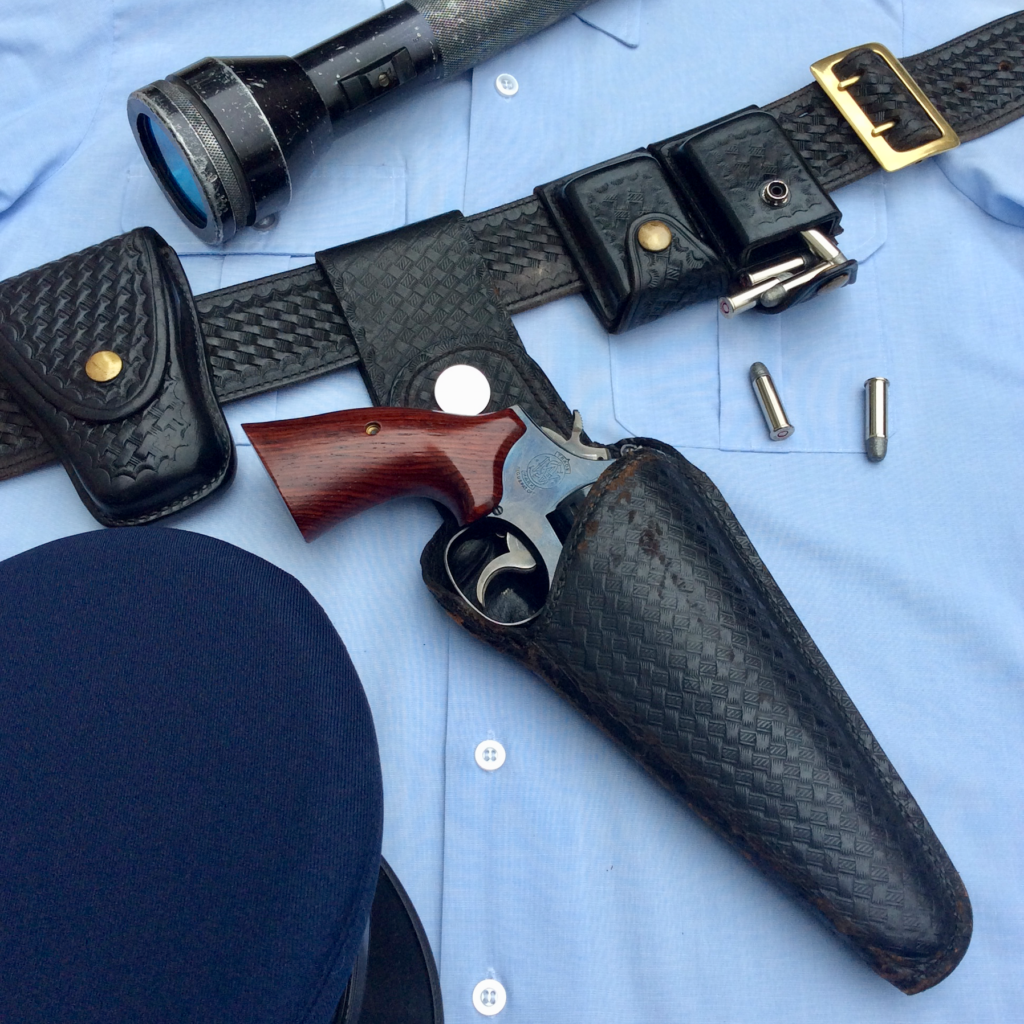
Besides, they had panache. A clamshell wasn’t your average, pedestrian, top draw rig. It was sexy, and reeked of the gunfighter mystique. If you wanted to look cool, it was your huckleberry. Drawing a revolver from a clamshell wasn’t just an action, it was an event! With a pop of a spring and a flash of motion, a bad guy immediately found himself staring down a sixgun barrel before he could even blink!
And that didn’t just look cool . . . it was cool.
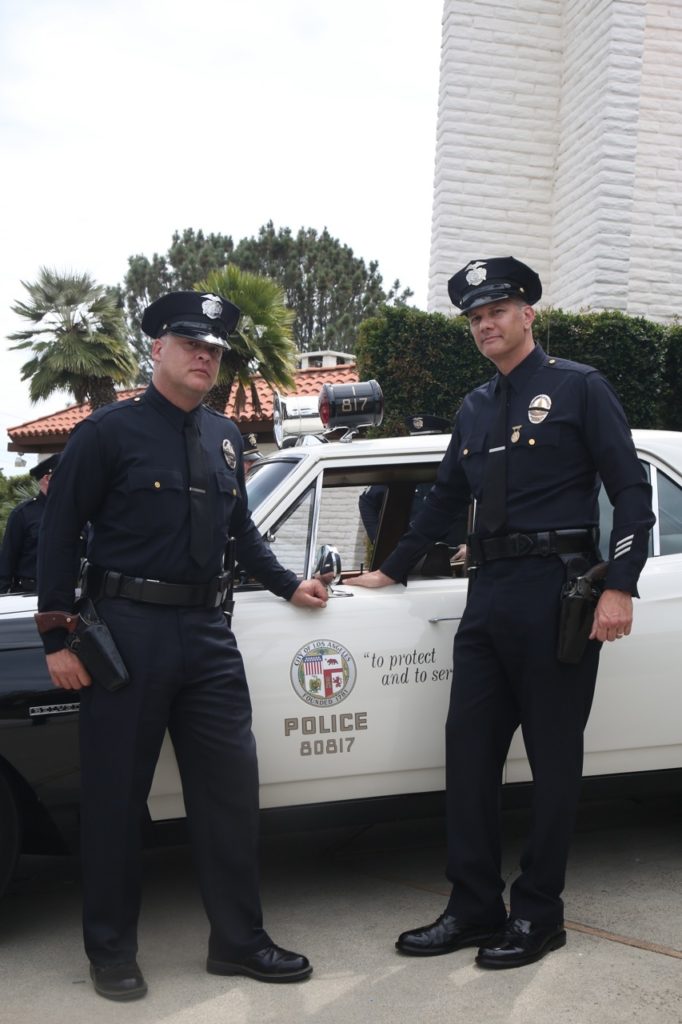
*****
Note: The author would like to thank LAPD Sergeant Kevin Ahlemeir and Vintage LA Coppers for their assistance with this article. Please see the website at: http://www.vintagelacoppers.org

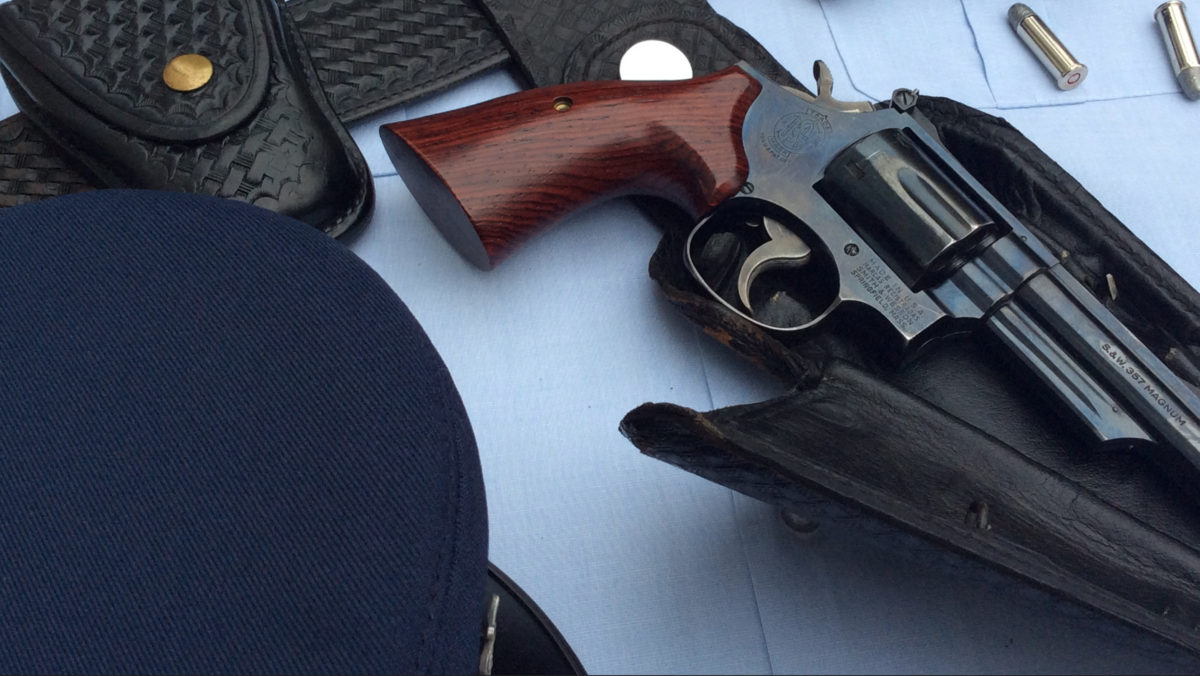
Would love you to do an article on the Audley holster and its variants. You provide great detail and photos. Thanks for your hard work.
Thanks Tim, that’s actually on my radar! I just have to find a good sample, first.
Wow, thank you! I cut my teeth on the front break Safariland but knew nothing about the clamshell other than the name. I also thought it pretty cool to see the dump pouches in some of those photos. Fascinating and informative article, keep up the good work!
Riley, I’ve got another project in the works that I think you’re gonna like!
Part II with more photos Mike!
Thanks! I have a good source to help me find some . . . ; ^ )
Love these history articles.
Keep up the great work!
Thanks David! We’re having fun here and I’m glad you’re enjoying the ride!
An outstanding article once again by this fantastic author. Very detailed and informative. AWESOME JOB!
Loved the article. At one point I had to have one in my collection. The hardest part was finding one for a 4 inch ( I’m a short guy and could never carry a 6 inch). I found a perfect condition Safety Speed Hi-ride for a 4 inch L frame on Ebay. I’m embarrassed at the obscene sum I paid to own it.
One of my sergeants used one of these for a while (we were issued S&W M66 at the time). After seeing him have to fiddle around with it to re-holster, I came to the conclusion it was a useless design for LEO’s. Then he let me borrow it over some days off so I could try it myself. Turned out I was right. In that era, a finger inside the trigger guard wasn’t considered an issue, but I could easily see how ND’s could be had with this holster design. I did think it wouldn’t be a bad deal for a handgun hunter, considering draws and holstering are mostly deliberate in such a situation; not a lot of ‘quick draw’ scenarios when you’re hiding behind a bush waiting for Bambi or ol’ Wiley.
All that said, I do appreciate the research and history lesson. I didn’t know the design was as old as it is, and can only wonder why it was so popular in California–then again, it is California….
I’d like to have one just for the sake of having one, but certainly would never allow it to be issued for real use.
Thanks for taking the time to research all this, then sharing it with us. Ace
Where I worked we didn’t hide behind bushes. We fought the bad guys head on. I moved from California because of their politics, but I can assure you the police officers I worked with, I would have gone to war with any day. Don’t discount the police officers in California because of the politics of the State they work in. Police officers have little control of the politics in the State in which they work. My son is a police officer in California and he is a good man as are all of the officers who he has the pleasure of working with. From my experience in working with many officers from many states California police officers are some of the best trained and competent officers around.
Don’t discount a clamshell holster because you were not able to operate it. I suspect it was operator error, which does not mean it was not a good holster just not a good holster for you. Different officers carried all kinds of holsters, they carried what worked for them and what they were skilled at using. The clam shell may not have been perfect, but it worked for me as well as hundreds of other skilled police officers.
Slow down, Mr. Cosgrove. If you read the whole comment, you’ll notice that Ace was referring to handgun hunters hiding in the bushes, not California police officers. Nor was Ace being disrespectful of police generally, or California police officers specifically. If you’re looking for an argument you’ve come to the wrong place, because I won’t allow it here.
Justin
Completely agree! When I worked in California in the early 90s I worked with real street cops, some left over from the 60s and 70s, they were always willing and able to go to war. When 11-99 came over the radio you knew the Calvary was on the way.
Adam-12 (WWMD??) seasons 2 & 3 used Safariland #11 holsters with “normal” safety straps as opposed to the finger-tip release of the Ojala pattern LAPD holster used the first year. Safety Speed also produced that one.
Two writers in 1960 and 1970 declared the clam shell obsolete and dead. In 1985, the SWAT magazine holster test found a non-swivel version to be an excellent police holster. Go figure.
So, the Serpa has an ancestor from the revolver era. It, too, has it’s fans.
Ha! Indeed. This is a big part of the reason that these holsters were disapproved for duty use in the CHP by the early 1960s.
I worked for a suburban SoCal department adjacent to LAPD. Several of us there carried in clamshell holsters. Mine was a LH Safety Speed swivel, purchased in the late 70’s. It is simple to reholster one handed with proper technique. It is not fast however. Pretty sure I stuffed my gun into my waistband on more than one occasion rather than reholster. I liked mine quite a bit and still have it. I bought it originally for a 4″ K frame, but had Safety Speed convert it to fit a 4″ L frame when my department switched to the 686 from the Model 15 in the early 80’s.
David, thanks for sharing the story! I’m glad you hung onto it. Did they replace the outer part of the shell, or just reshape it when you went to the 686?
I bought one from Saftey Speed Montibello around 1982. I remember having a phone conversation with an employee. When I told him I was left handed, he balked and said he’d have to custom make it and it’d be expensive. It was…$200! Great holster though. Super fast. Also great for retention, all you had to do was hold it shut or swing it up and trap it against your rib cage. Mine opens just past 90 degrees, so one handed reholstering was pretty easy, if not fast. Also the stud for the swivel was peened and had a cotter pin. I loved this holster. I retired it in 86 when we switched to the Sig P220. Safety Speed refused to make me a lefty for the Sig! A few years before I retired, I returned to Patrol. I dusted off the clamshell and my S&W 19 and practiced with the rig and my Second Six loaders for a couple weeks. Was like riding a bike! Carried that until I retired in 2010.
2010? That’s pretty neat, Dave! What part of the U.S. were you policing in? It seems that I’ve never met a copper outside of California who used a clamshell on duty. Thanks for writing in!
Hey Mike! I retired from Newport Beach PD, but attended LAPD’s academy in 1980. Most of our brass was retired LAPD, so we had the good fortune to go there. I saw some clamshells worn by LAPD vets. Also, as a young pup, some of my partners were laterals from Pasadena and this was where I got to see these clamshells up close.
It did raise eyebrows of our brass when I started carrying my old Model 19/Safety Speed. One Lt. told me I couldn’t carry like this but our manual still allowed us a “Smith & Wesson, Colt, or Ruger Revolver.” Yup, hadn’t been updated in years! Oh well, I was an old guy by then, so they pretty much let do my own thing.
I saw Larry Mudgett’s post below, good to know he’s out there…the man’s a legend!
Dave, it’s great to hear from you. Thanks for adding to the story of the clamshell! Yes, I thought it was cool too, that Mudgett stopped by RevolverGuy! Hopefully he’ll become a regular and share some of his experience in these pages.
I was a cop in the Detroit area from 1967 to 1982. I bought my own clamshell around 1970 or so and used it every day on patrol. I still have it. Thank you for the article, I never knew about their history. I had heard about them from other officers. Oh, and most of you are right. Mine sprung almost 180 degrees, so it was tough to put the weapon back and next to impossible with one hand.
Richard, welcome aboard! Glad to have you here, and THANK YOU for your 15 years of service during a dangerous era for LE. I’m glad you enjoyed the article, and hope you’ll feel free to poke around here in the various pages and discover the other fun stuff we’ve written about. There’s a 1970s speedloader article that might bring back a few memories!
San Antonio Texas PD was where the clam shell was popular. i carried mine until 1995 when we switched to Glocks.
LAPD went to the Model 15 in 1969 as I was issued one at that time. I started carrying a clam shell in 1970. I never had to draw my gun prematurely as the clam shell was so fast that it was as if I always had my gun out. I quickly mastered the technique of re-holstering with one hand. It was not hard to do once you knew how. I owned at least 5 clam shells and carried one for 17 years. I still have 2 of them. I also switched to the model 14 6 inch revolver, then to a model 19 until magnum revolvers were banned by Chief Davis. One of the conditions of switching to auto pistols about 1986 as I recall was to give up the clam shell holster. This was due to several negligent discharges blamed on the holster. The clam shell was an awesome system for those who were well trained with it. It is a piece of history. Larry Mudgett #15467
Sir, I’m glad to hear from you in these pages! Thank you for writing in and adding to the story of these iconic holsters.
Hey Mike, if you ever get a chance I think a great review for fighting gunleather would be the old Safariland model 275. I believe they were the finest revolver duty holsters ever made. Combining speed with security. They were discontinued awhile ago but you can still find them on ebay. As always great article and I plan on getting your book soon. Thanks.
Thanks Martin! I’m working on an article that I think you’ll enjoy. Stay tuned!
I sure wish they still made them. I was a police officer for Vallejo PD from 1981 until 2010. when I started most of the old timers had clam shells and I bought one as soon as I could. I carried one my whole career. First with my Colt Python, then in the late eighties the department switched to a Sig Sauer 226 9mm, and later to a 229 .40 after several shootings where the 9mm was not effective. I bought a high rise clam shell and then switched to the low slung swivell which put my Sig level with my hand. It was the fastest holster ever made. In order to carry it, I had to qualify with it using only one hand to put it away. I did this by dropping my finger behind the trigger until I felt the notch the trigger guard hung on and then closed the holster with the same hand. The notch they started making in the later models made it so much easier. The department let me carry it until I retired, our senior Sgt. was the only other officer who carried one, he retired about a year and a half before me. Lots of officers wanted that holster when I retired but I still have it. I am guessing that I am the last police officer to ever carry the clam shell holster. I was in a few shootings in my career and it always worked like a charm, when we were qualifying no one could beat me on the draw. Thanks for the article now I know the whole story on a holster that served me well. Thanks
Mike, I have a question about my 1962 revolver. Would you email me please? Thanks
Happy to try and answer it! Send me an email using our contact page, and I’ll take a swing.
https://revolverguy.com/contact/
Hey Mike! Awesome article! I have 4 clamshells including a full replica of the Adam 12 belt and a high-ride python clamshell! If you know anything about the famous “Lewis” Holsters, I’d love to read an article about it!
Thanks, Andrew
Thanks Andrew! I’m working on a crossdraw article where Lewis will get a mention!
Hey Mike….really great article I stumbled across…my ‘grown’ kids gave me the Adam-12 DVD set for my birthday….wow, what memories….I was with San Antonio PD, we were issued Safety Speed breakfronts out of the academy, really good and safe holster. But I carried a high rise , no swivel, clamshell with my M66 4 inch, really fast, worked great with LOTS of training! Actually too great early on for me, with one of those accidental discharges after drawing….I was conducting a requested (dumb ass on my part) demonstration, how quick it was, and popped a round off….I did turn away from personnel for safety you know….of course….duh….you know, do not point at anything you’re not willing to destroy!….Well I was willing to destroy the chest freezer in our helicopter detail office, and almost did so! No helos shot, nothing else destroyed but my pride and $600 later that day to buy them a new freezer. Thought my pilot application would be shredded. Got days off, the unwanted kind….4 months later got called back up to see the sergeant and offered a job….as long as I promised not to shoot anything else there! My 1st day walking in the office early, I found sillouhette targets over everything, with comments….we need a new tv, the fridge isn’t cold, the computers need replacing…..stay away ftom the freezer, it’s NEW!…..leave the helicopters alone!!!
Yeah, you’re article hit a nerve! But thanks so much!!!
Danny Thompson
Haha!!! Danny, that story takes the cake, and is now my favorite clamshell story! Gotta love pilot humor! Glad you enjoyed the story, and hope you’ll stick around and check out the other fun stuff here.
Mike, just read your article on the clam shell . I was a street cop on LAPD in the late 60’s thru the early 80 ‘s. I carried the standard 4 inch smith with a safety speed clam shell. I can remember guys practicing quick draws in front of the mirror in the police locker room. Those were the Days. We all had nick names it was a street cop thing. My nick name was Jump-in – Joe
Jump-In-Joe, GREAT to hear from you! I hope you’ll stick around and check out the other great stories here on RevolverGuy. Thanks for adding to the neat history of the clamshell story.
I had no idea that the clamshell holster was still being used by some officers in the early years of the 21st Century! I thought it went away with the Seventies.
Isn’t it neat how some things just keep truckin’ on? There’s probably still a few left on the streets!
I am currently cleaning out my parents’ house. I have my father’s, Stockton PD 1941-73, full belt rig with Jewett Clamshell w/38 Police Special. In 1947, he was shot in the stomach with the bullet lodge against his spine. Going down, he popped that Jewett and fired five shots, four hits. Burglar spent the rest of his life in prison. In an article in the FBI Bulletin, he credited his response to FBI training the department received the year before- drop to the left, learn to fire from the hip. Copies of the Bulletin came with a letter from J Edgar Hoover. Top of a closet, I find the complete evidence box including burglar’s gun! Dad lost part of his stomach and one third of his intestines, but returned to work. Only difference was he switched to a S&W 357 Magnum- “Next one wasn’t going to prison”. In the early 70’s, by then a Watch Commander for years, he switched back to his ’40’s rig so he wouldn’t be “out of uniform”. The Chief had wanted him gone for years and that was the latest ploy. So much history that black leather had seen.
Bart that’s an AMAZING page to add to the story of the clamshell! Thank you so much for sharing it with us! Your dad sounds like he was a hell of a cop, and knowing Stockton, I’m sure did some tough policing in some tough neighborhoods!
I’m so glad you have the story to go with the gear. Write it down for your family and keep it with the equipment so that it outlasts you.
If the leather is dry, make sure to use a little neatsfoot oil to preserve it.
Mike:
I really enjoyed this article about the clamshell holsters. As I mentioned after reading your book, I carried a 4″ clamshell until the department (LAPD) wouldn’t allow them any longer. I loved that holster and was never the victim of any of its disadvantages. If they ever took old dinosaurs back on the street I’d be happy to carry a clamshell again. I always believed that officers who had accidental discharges tended to blame the clamshell even if it wasn’t at fault because it was a plausible excuse.
Great article! Keep it up.
Thank you Sir! I’m glad you enjoyed the article and hope you’ll find more to enjoy in these pages!
Hello Mike: Like the other readers, I really enjoyed the history on how the clamshell holster came to be.
I came across a right hand swivel model from an auction site and wondering if you could help identify what revolver it fits. The markings on the back are 4S 357M 57 4. Any help on this would be greatly appreciated.
Hi Ron, I’m glad you enjoyed the article.
It’s hard to know without seeing the holster, but I’m going to take my best guess, and maybe it will be helpful. I’m not sure, but I think your holster is for a 4” S&W N-frame revolver. Does it look like that’s possible? Is it for a 4” gun with a big frame?
Decoding guess:
The “4S” could be shorthand for, “Four-inch S&W” or possibly “four-inch, swivel”
The “357M” is likely shorthand for “.357 Magnum”—this could be a reference to caliber, but instead I think it’s more likely a reference to the S&W pre-Model 27, which was simply called, “The .357 Magnum” before model numbers were assigned to all guns in the 1950s. This is an N-frame (Large frame) revolver.
The “57 4” could be a holster model number and another reference to “four-inch.” I suppose it could also be a reference to “Model 57 4-inch,” which is another N-frame revolver, like “The .357 Magnum.” The holster would have to date to the 1960s (1964 or later) for the Model 57 reference to be correct, but since the Model 57 and The .357 Magnum (Model 27) could probably fit the same holster, maybe that’s what it is.
Whaddya think?
Great holster. Carried it for years as my father before me and only retired it when we went to semi autos in 1990’s. Saved my life one day when a bad guy surprised me on a porch with a 12ga shotgun. He jacked a round in while I yelled to stop, but I had my S&W in my hand instantly and fired first at 70 ft. Instant knockdown only nano second away from him firing first.
Retired Oakland police officer, 39 yr vet law enforcement.
That’s one heck of a testimony for the clamshell! Glad it worked so well for you. Oakland was a tough city to police for 39 years—thank you for all you did to make it safer for the good folks.
Great article, when I first started I was issued the SW 66, with issues Safariland holster. Older cops had the clamshell, never had the privilege to carry one.
Glad to have you join us, Steve. Thanks for your years in the trenches.
OK here. Interesting article. I just dug out my clamshell and she is a JAT. Now I know who made her. My LAPD serial is 17081, indicating I started in July 1971, well over 50 years ago. I was issued my holster when I started my L.A. career, and carried her on and off until we switched to Berettas.
We were trained in the clamshell and trained well. It was fast and had a smooth draw, and I drew on numerous occasions. This was the 70s, and even working Rampart, we mixed it up with the SLA, Weathermen, Black Panthers, Black Muslims and Brown Berets. I won’t say shootings were a daily occurrence, but several times a week. Most of us liked the clamshell and it was a popular way to carry our Model 15s.
I did have a classmate whose leg blew up with a .38 hole in it. Talked with him over coffee, and according to him, he was riding passenger in a B&W. We used Mercury Montegos that year. (Horrible patrol vehicles). His holster had fallen into the gap between the seat and door, when he exited the vehicle, the holster twisted and when he pushed down on the grip to settle the holster, the trigger, which had been displaced behind the half moon which normally sat behind it, fired, into his leg. He returned to duty after six months but never again trusted a clamshell or Merc again.
3L120, thanks for checking in and sharing your firsthand experience with the clamshell! I’m glad you still have your JAT. Dangerous times, back when you started, and I think we’re right back there today. The parallels are undeniable between policing in the 70s and now.
Memories! Compton PD here. Carried the clamshell my entire career. The best feature was while sitting in the patrol car I was able to have my gun resting nearly on my lap. Many times one of our local Comptonites would walk up on me while I was parked. I could push the button and have my model 66 in my hand inside 1 second. These fine upstanding citizens had no idea i had my gun pointed at them the whole time.
Ed, glad you found the article and shared your memories with us! Compton was a tough beat! Did you serve there until the end, when LASD took over?